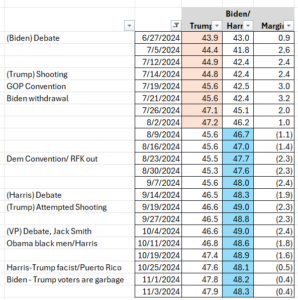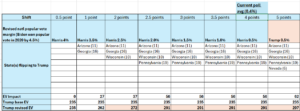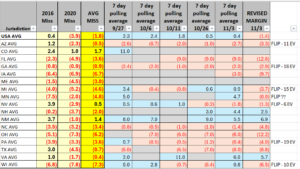Introduction
Early voting is wrapping up across the country, and polls will open in less than 48 hours. What are the pre Election Day polls telling us?
Presidential Polling
The main challenge that the party in power/Democratic nominee Kamala Harris has is that (1) the Biden Administration remains unpopular (41.5-55% approval/disapproval according to a 7-day average of polls taken, which is almost identical to 42-56% last week), and (2) the negative mood of voters: they by a 64-26% margin believe our country is heading in the wrong direction.
Still, because of (1) existing polarization and (2) strong opinions (both pro and con) for/against the major party’s nominees, polling numbers haven’t moved that much the entire election cycle. The latest 7-day average of polls shows Harris with a 0.4% national popular vote lead, which is almost unchanged from last week. To put this “lead” in proper perspective, Biden (according to RealClearPolitics) at this point in time in 2020 was ahead of Trump by 7.2%, while Hillary Clinton in 2016 was up 1.8% over Trump.
Given the narrowness of Harris’ “lead” in the national popular vote, it’s possible that Donald Trump can win the national popular vote for the first time for reasons that will be explained later in this article.
Below is a representation of the weekly changes in the national poll averages since the Trump/Biden debate:
National popular vote vs the Electoral College
While much press attention is given to national popular vote polls, it’s the Electoral College that actually elects a President. That marginally benefits Republicans due to an inefficient vote distribution of Democratic and Republican votes across each state. In other words, a Republican can be elected President without attaining a popular vote majority (or even a plurality), because California and New York have in recent election cycles generated larger Democratic vote margins than Florida and Texas have for Republicans. And while large margins in California/New York “run up the (national popular vote) score”, “running up the score” doesn’t get a Democratic candidate any closer to the needed 270 electoral votes – winning critical swing states DOES.
To illustrate the disconnect between the Electoral College and the national popular vote, Joe Biden was elected in 2020 with a 4.5% popular vote margin (51.3-46.8%) over Donald Trump, but his victory was (using applicable 2024 numbers) a 303-235 Electoral College win (270 electoral votes are needed to win), Biden’s Electoral College victory was due to narrow victories in several states, like Arizona, Georgia, Michigan, Nevada, Pennsylvania, and Wisconsin.
Because Biden’s win was so narrow, ANY movement towards the Republicans relative to a 4.5% national popular vote will “flip” swing states: even Harris’ winning the national popular vote by 3.5% (something that has NOT happened in this election cycle) enables Trump to flip Arizona and Georgia (putting Trump up to 262 electoral votes), because of Biden’s tiny margins of victory in those two states.
In fact, Trump theoretically can get to 270 electoral votes with a 2.5% Harris national popular vote win (in other words, a two-point nationwide shift across the country), because a 2.5% Harris win would theoretically flip Wisconsin’s 8 electoral votes.
However, Harris has a 0.4% national popular vote margin, and that 2.1-point shift relative to 2020 would theoretically enable Trump to “flip” Arizona, Georgia, Wisconsin, and Pennsylvania, and get him to 291 electoral votes – and the Presidency.
Polls/polling errors
There is another way to assess the state of the Presidential election: examine the average of the last 7 days of polling for each swing state, and take into consideration known understatements of Trump support both in 2016 and 2020.
From a literal reading of the last 7-day average of polls, Trump would “flip” Arizona, Georgia, Nevada, and Pennsylvania, which gets Trump to 287 electoral votes – more than enough to win.
If previous polling errors were taken into consideration (editorial note: JMC is a professional skeptic about previous errors’ being fixed in 2024 without proof to the contrary – “contrary” being Election Day), Michigan and Wisconsin would also shift into Trump’s corner, thereby increasing his electoral vote total from 287 to 312 electoral votes. Depending on partisan intensity from the early and Election Day vote, Minnesota moves onto the political radar given prior polling “misses”, although it has not voted for a Republican for President since 1972. Below is a graphical depiction of “polling misses.”
The early vote
While Election Day isn’t until November 5, an increasing number of voters are choosing to vote before that. Research done shows that 45% voted early in 2016, and that number surged to 69% in 2020. While the pandemic/mass adoption of mail voting certainly contributed to the increase in early voting in 2020, the reality is, Election Day voting is nevertheless becoming a thing of the past for an increasing number of people, which DOES impact the timing of when campaigns need to disseminate their messaging to voters.
This past week, early voting reached its peak, and is now steadily wrapping up across the country. As this article is being written, these are the major takeaways from early voting:
- At LEAST 76,416,795 have already voted (“at least”, because not all states publish early voting statistics, and not all of those who do update in a timely manner). At this point in time in 2020, 94,171,581 had early voted;
- Noticeable drop-off in (Democratic friendly) mail in voting: JMC estimates a 39% drop-off (or 15.5 million votes) in mail volume, which is only partially being offset with increased in person early voting – JMC estimates in person early voting increased 19%/4.5 million over the previous Presidential election cycle;
- Republicans’ being more motivated to vote early: in 2020, JMC calculated that at this point in time, Democrats had a 16 point (46-30%) advantage from a party registration standpoint; this time, its only 3 points (39-36%);
- In states that track the race of a voter (for example, Georgia, Louisiana, and North Carolina), black voting intensity is noticeably less compared to 2020– to use one example, as of last night in Louisiana, 25.5% of early voters were black, compared to 30% in 2020 (blacks make up 31% of registered voters in the state). A similar dynamic is happening in Georgia and North Carolina – Kamala Harris absolutely needs a robust black turnout if she wants to hold Georgia and/or flip North Carolina;
Conclusion
While the “safe conventional wisdom” is that “it’s a tied race/Kamala will win”, the data (voter registration, early voting, polling, and/or polling with known “misses” factored in) does not support this assertion. Still, randomness is a fact of life in the political world. Whatever the result, the Number 1, 2, and 3 job for either campaign now is turnout. There are very few voters who COULD be persuaded at this point.



